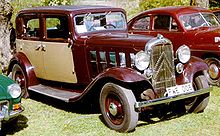Citroën Rosalie
| Citroën | |
|---|---|
|
Citroën Rosalie Coupé 15 CV
|
|
| Rosalie | |
| Production period: | 1932-1938 |
| Class : | Lower middle class , middle class , upper middle class |
| Body versions : | Touring car , roadster , sedan , coupé , convertible , panel van , pick-up |
| Engines: |
Petrol engines : 1.5–2.7 liters (26.5–41 kW) |
| Length: | 4240-4720 mm |
| Width: | 1720 mm |
| Height: | 1670-1690 mm |
| Wheelbase : | 2700-3150 mm |
| Empty weight : | 1300-1500 kg |
| Previous model |
Citroën C4 (1928) Citroën C6 (1928) |
| successor | Traction Avant |
The Citroën Rosalie was originally a lightweight racing car that had several successes at the Autodrome de Linas-Montlhéry . This resulted in the Rosalie 8 CV, 10 CV and 15 CV car types, i.e. vehicles of different sizes or classes. The cars were built between 1932 and 1938. There were not only different wheelbases and sizes, but also a wide variety of bodies, from elegant convertibles to delivery vans.
history
The Citroën Rosalie replaced the C 4 and C 6 models. The Rosalies were available with different bodies and interiors, from open two-seater to limousines to delivery vans with box or flatbed bodies . Due to the assembly line production , the vehicles were inexpensive.
In 1934 the improved Rosalie NH was presented, whereby NH (French = nouvel habillage) means something like facelift . The main feature of the NH models was the new independent front suspension on double wishbones . In all Rosalies the engine was elastically mounted, which increased driving comfort.
The successor to the Rosalie was the Traction Avant . Diesel engines were also offered for the Rosalie-based delivery vans.
Like the predecessor models of types B14 , C4 and C6, Rosalies in the Ganz German version were also manufactured in the German Citroën production plant in Cologne-Poll between 1932 and 1934 , where 1,823 models of the successor Traction Avant were also assembled from 1934.
Model variants
8 CV
The 8 CV was the smallest vehicle in the Rosalie series. He had a four-cylinder - engine with 1,452 cc displacement and 32 hp. Power was transmitted to the rear wheels via a three-speed gearbox, and the maximum speed was specified as 90 km / h. The 8 CV NH Légère, built in 1934, had 36 hp.
10 CV
With a length of 4.57 m, the 10 CV was 30 centimeters longer than the 8 CV and was equipped with a four-cylinder engine with a displacement of 1767 cc and 36 hp. The other technology corresponded to the 8 CV. Several body variants were available for the 10 CV as well as the lighter Rosalie 10 CV Légère version.
15 CV
The 15 CV version of the Rosalie had a six-cylinder engine with a displacement of 2650 cm³ and 56 hp. Because of the larger engine, the front end had to be lengthened by 15 centimeters. This car was also available with different bodies and equipment, and there was also a Légère version that reached a top speed of 120 km / h.
The 15 CV was built under license as the Type MF 6 by the Austrian automobile company Gräf & Stift .
Web links
Individual evidence
- ^ Citroën automobile production plant in Poll . In: KuLaDig, Kultur.Landschaft.Digital. (accessed April 5, 2020)
- ^ Hans Seper: The Brothers Gräf - History of Gräf & Stift - Automobile . Welsermühl, Wels-Munich-Kreuzlingen 1991, p. 177-178 .


